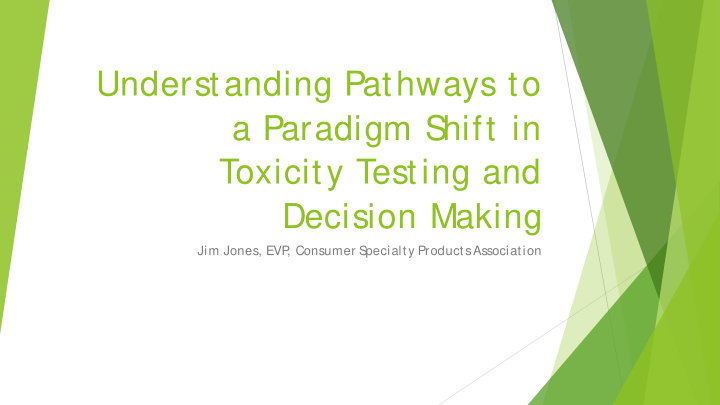



Understanding Pathways to a Paradigm S hift in Toxicity Testing and Decision Making Jim Jones, EVP , Consumer S pecialty Products Association
cience Fact ors in Int egrat ing 21 st Non S Cent ury S cience int o regulat ory decision making: EDS P Context Program Key Factors Organizational S kill mix S takeholders Policy Choices S ummary
Cont ext of Endocrine Disrupt or Screening Program (EDSP) EDS P assay development post FQP A occurs from 1998 (after getting advice from EDS TAC) through 2008. It took a decade to develop the battery of 11 tier 1 assays to screen for estrogen, androgen, and thyroid disruption. April, 2009 EP A issues test orders for the first 67 chemicals for Tier 1 screening. Data is submitted and reviewed by 2013- 4 years after assays are required. Early in the process (1998) EDS TAC advised EP A that high throughput methods were not scientifically robust enough for screening.
Cont ext R esearch by EP A ’s Office of R esearch and Development and its National Center for Computational Toxicology (NCCT), creates the potential for high throughput techniques to replacing some EDS P assays but not all. (Estrogen and Androgen related assays in particular). The question for EP A: Does it move away from an approach that took years to develop for an alternative approach that still requires further scientific development. If so, how does it manage this “ pivot” ?
Cont ext : Jim’s Hierarchy of Applicat ion (fit for purpose and problem formulat ion) Prioritization and S creening Integrate with animal data (WOE) Custom design a chemical data set R eplacement Risk Assessment
Organizat ional Issues Multiple organizations involved: R esearch (ORD); EDS P program office (OS CP in OCPPS ), OPP (in OCS PP): Each has different cultures and obj ectives with respect to how to implement the Endocrine mandate. ORD focused on the use of cutting edge research. OS CP has spent 10-15 years on a framework j ust finalized and beginning to be implemented. Vested in that framework. OPP is focused on its deadline to re-review all pesticides by 2022 and trying to ensure whatever approach is selected allows them to meet their statutory deadline.
Skills mix Underlying some of the organizational issues. There are varying degrees of expertise in understanding computational techniques. Highly trained individuals who are national and international experts at hazard assessment, exposure assessment and/ or risk assessment under that traditional animal based framework may not have the same status under the new framework. The individuals with the most experience in the new techniques often don’ t have expertise in risk assessment and other aspects of regulatory decision making
St akeholders It is necessary but not sufficient for stakeholders to understand the basis of decision making. To its credit EP A ’s ORD NCCT held monthly calls open to all stakeholders in an open forum to discuss ToxCast. OCS PP (the program office) relied on traditional means of getting stakeholder input/ buy in: Peer R eview, Policy FACA (PPDC), Notice and comment on program implementation. . Peer R eview: EP A peer reviewed approaches to use HTS s before deploying several times (one scheduled next week). PPDC: EP A routinely used its FACA advisory group to inform and get advice on its plans routinely. EP A took comment through FR Notices on its planned approach.
Policy Choices When and how t o “ pivot ” from t he old approach (11 t ier 1 assays) t o a new approach? By June 2015, EP A was comfort able t hat HTS from ToxCast were adequat e t o replace 3 of t he Tier 1 assays (relat ed t o Est rogen). EP A at t hat t ime said it would accept t he HTS as replacement s. Should EP A cont inue t o issue orders before t he ot her 8 assays could be replaced? Ult imat ely EP A decided not t o cont inue issuing orders but t o focus on science development of High Throughput t echniques. Next week EP A will present t o a peer review HTS t echniques t hat may allow for replacement of some of t he Androgen relat ed assays. In t he short t erm we’ ve delayed t he screening of chemicals wit h t he plan t hat moving t o HTS will ult imat ely lead t o much fast er screening of t he universe of 10,000 chemicals ident ified for screening. EP A has also det ermined t hat it could use ToxCast and ExpoCast t o det ermine t he order of screening chemicals (priorit y set t ing)
Summary There are numerous non technical factors that are important to manage when attempting to integrate new science into a regulatory process. Arguably, priority setting is the most straightforward from both a scientific and programmatic implementation perspective. EDS P offered a very challenging context although the upside was so big (the science was well under way and the status quo would take decades to implement). S enior level engagement is critical.
Recommend
More recommend